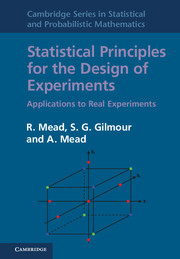Book contents
9 - Multiple levels of information
from Part II - First subject
Published online by Cambridge University Press: 05 November 2012
Summary
Preliminary examples
(a) In an experiment to investigate the effect of training on human-computer-human interactions, six subjects were randomly allocated to each of four training programmes. Subjects were then paired into 12 blocks using two replicates of an unreduced balanced incomplete block design. Each pair carried out a conversation through a computer ‘chat’ program. In addition to several response variables measured on each subject individually, each pair was given a score by an independent observer, for the success of their interaction.
We have only a single response representing each block. Can we use this information and, if so, how? If we can, do the block totals contain useful information about the effects of treatments on other responses? Does this affect how we should design the experiment? In particular, for this response, should we have used some blocks with both subjects getting the same treatment?
(b) Eight feeds are to be compared for their effects on the growth of young chickens. The experiment will be carried out using 32 cages, arranged in four brooders, with each brooder having four tiers of two cages. Should the experiment be designed to ensure that each treatment appears once in each brooder and once in each tier, or should we consider the brooder×tier combinations as blocks of size 2 and choose a good design for this setup? Can we do both simultaneously?
Identifying multiple levels in data
In Section 7.3 we considered the analysis for general block–treatment designs. However, in that analysis only the information about treatments from comparisons within blocks was considered.
Information
- Type
- Chapter
- Information
- Statistical Principles for the Design of ExperimentsApplications to Real Experiments, pp. 218 - 232Publisher: Cambridge University PressPrint publication year: 2012
